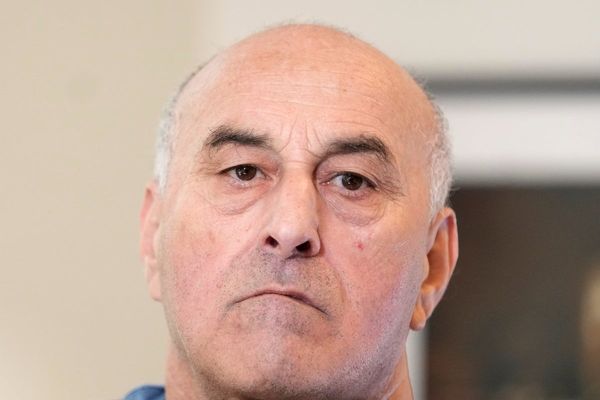
A self-driving Uber at a media preview in Pittsburgh last year. Uber chief executive Travis Kalanick will take a leave of absence for an unspecified period. (Gene J. Puskar/AP Photo)
Uber founder and chief executive Travis Kalanick’s decision to take a leave of absence from the ride-hailing company after the death of his mother in a boating accident and amid a vast overhaul of the company's hard-driving culture is, to say the least, unusual. Management experts have been hard-pressed to think of any companies of Uber's size whose CEOs had temporarily stepped aside for reasons other than medical conditions.
But perhaps even more unusual is what Kalanick is leaving behind: A shell of a management team that, as of Thursday morning, had at least six vacant senior jobs, as well as no clear executive in charge at a company where the CEO has long held a consolidated level of power.
The board did not immediately name an interim CEO. There is no natural second-in-command yet who could take the reins. Instead, the embattled company said it will rely on a team of 12 executives to carry out one of the most challenging makeovers in business today, managing sprawling crises with no clear leader at the helm.
"The simple answer is I’ve never seen this before," said David Yoffie, a professor at Harvard Business School who is a board member at companies including Intel and HTC Corporation.
Typically, he said, there's an obvious executive who can step in -- a chief operating officer, president or chief financial officer -- or the company will name a member of the board with plenty of executive experience to be in charge on a temporary basis. But Uber has no COO -- it has been searching for one since March. Its president left the same month. And it has vacancies in other key jobs that include CFO, general counsel, chief marketing officer, senior vice president of engineering and chief diversity officer.
[‘Now it’s on our watch’: A chat with the new Uber executive who believes the company can change]
"This is especially problematic for a company that's in crisis. It's hard to see how any fundamental decision can be made," Yoffie said. "One would hope the board will re-evaluate what the appropriate leadership structure is, even on a interim basis."
The challenges are extraordinary. A blog post written by a former Uber engineer in February alleged a sexist workplace with dysfunctional management oversight, further catapulting the company's aggressive culture into the spotlight. Soon after, a video surfaced of Kalanick berating one of Uber's drivers, prompting him to publicly admit "I need leadership help." Former attorney general Eric Holder and the law firm Covington & Burling were brought in to do a comprehensive review, making 47 recommendations to overhaul Uber's culture -- many of them consisting of basic management tactics -- all of which the company's board has said it will adopt.
But that's only just the start of the company's rough year: Executives have been heading for the exits, a federal probe has been launched into Uber's use of a secret software program, and the company has been engaged in a legal battle with the self-driving car unit of Google's parent company, Alphabet, over alleged theft of intellectual property. Capping it all off was the sudden resignation Tuesday of billionaire board member David Bonderman, who cracked an "inappropriate" joke about how much women talk in the boardroom at an Uber event actually designed to spotlight the changes the company would be making to make its culture more inclusive.
"They’re going to go nuts if they don’t have a final arbiter," said Michael Useem, a professor at Wharton and director of the business school's Center for Leadership and Change Management. "It's like Management 101. ... Nothing runs without one person at the top. Nature abhors a power vacuum."
Asked about the lack of an interim leader, an Uber spokesman said in an emailed statement that "we have a strong leadership team including veterans who helped make the business what is today and new talent who are helping to drive the changes we're committed to making. The entire team is excited by the opportunities ahead of us."

Uber CEO Travis Kalanick is taking a leave of absence from the company he founded. (Robert Galbraith/Reuters)
In the Holder report, recommendations the board has said it will adopt include changes at the board level, such as adding independent members and an independent chair, as well as reallocating some of Kalanick's responsibilities and looking for a COO with experience rehabbing corporate cultures and a background in diversity and inclusion issues. Twelve executives will be running the company in Kalanick's absence -- three who run the company's business in global regions, three product and engineering leaders, four officials on its legal, safety, policy and communications team, as well as its now high-profile human resources chief, former Google executive Liane Hornsey, and Frances Frei, a Harvard Business School professor it has hired to be "senior vice president of leadership and strategy."
In an interview with The Washington Post last week, Frei said "the candidates that we are considering and that want to be considered for this role are vast," referring to the COO search. And in response to questions about the company's leadership vacuum, Frei indicated the many open seats could have a hidden upside. "I’m not sure I would entirely choose it, but we have an opportunity that’s rare. We can bring in a set of people as opposed to individuals," she said, hand-picked as a team who can work together well.
Still, management experts said the massive challenges that lie ahead for the company will be even more difficult because of the lack of a clear point person at the top. "This is a very odd situation, with twelve people in a committee running a company -- that to me is a recipe for chaos," said Peter Crist, chairman of the executive search firm Crist Kolder Associates.
Bill George, a member of the board at Goldman Sachs who was a director when CEO Lloyd Blankfein was undergoing treatment for cancer, said that given the circumstances, it was a good idea for Kalanick to take a leave of absence. "But the big surprise to me is they didn’t appoint an interim CEO," said George, the former CEO of Medtronic who is also teaches at Harvard Business School. "The idea that the team's going to handle it and 'please call me on strategic situations' — if that’s really what they’re going to do, that's not a good idea."
[The big problem for Uber now: Attracting talent]
Indeed, in a letter to employees Tuesday, Kalanick said he would be handing management to his team and be accessible for high-level decisions. "During this interim period, the leadership team, my directs, will be running the company," he wrote. "I will be available as needed for the most strategic decisions, but I will be empowering them to be bold and decisive in order to move the company forward swiftly."
The lack of clarity at the top could also make recruiting more difficult, executive recruiters and management advisers said. Crist frequently sees top executives hesitate to take key jobs even in situations where a CEO is nearing retirement age, in which it's opaque who will lead the company several years in the future. That discussion could be even harder, he said, at a company where the CEO has taken a leave of absence and there is no interim named in his place. "Really high-level, smart people don't like risk," Crist says.
George agreed. "That’s a challenging position to recruit for," he said. "You're essentially asking someone to run the company without the power." The open-ended nature of Kalanick's leave -- he said in his letter to employees that the unspecified timeline "may be shorter or longer than we might expect" -- could make it even more difficult.
One thing working in Uber's favor, said Yoffie, is that the company's business is quickly growing, and remains quite decentralized by region. "So the actual operation of the day-to-day business probably can run more or less independently," he said. But even if there's little disruption in the service customers experience, he says the challenges the company faces will still be difficult to solve without a clear leader at the helm. "Hugely problematic would be the best way to describe it."
Whatever happens at the top of Uber, there's little question it will be watched and studied very closely. "This is going to be a classic business school case study, there’s no question," said Sydney Finkelstein, a professor at Dartmouth University's Tuck School of Business. "The only other organization I can think of that has that many unfilled positions at the top is the Trump administration."
Read also:
Uber CEO takes leave amid sweeping changes at company
Uber CEO says 'I need leadership help.' What should it look like?
Like On Leadership? Follow us on Facebook and Twitter, and subscribe to our podcast on iTunes.







